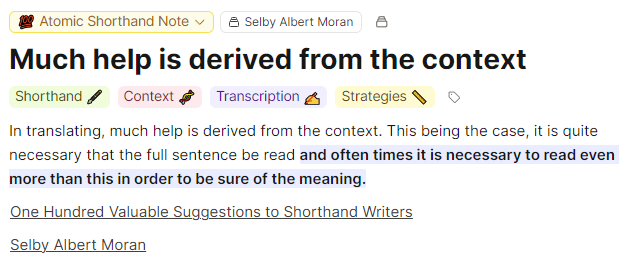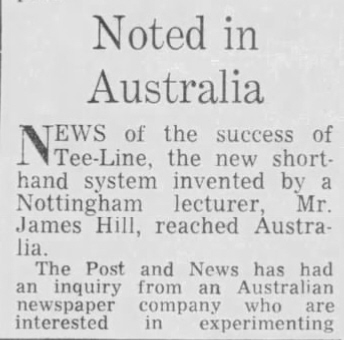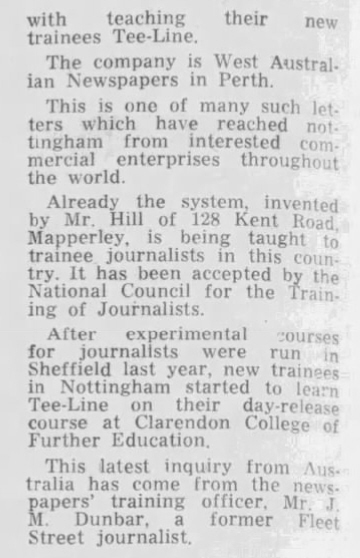LLTT Newsletter - October 2024

LLTT - October 2024
Welcome!
In this issue, we’re going to briefly discuss “context” in shorthand.
Next we’ll hear from Tom Burnett, a veteran journalist who shares his insights on mastering shorthand as a left-handed writer (“southpaw shorthand”), emphasising that dedication and consistent practice matter more than which hand you write with. Drawing from a decade of experience, he stresses that shorthand remains an essential skill in modern journalism, regardless of technological advances.
Let’s go!
Understanding and Utilising Context in Shorthand

In the world of shorthand, a phrase often emerges: “the context will tell you which word it is.” But what does this really mean, and how can you harness the power of context to enhance your Teeline?
At its core, context in shorthand refers to the surrounding information around a word (or words) that helps us to understand a particular outline or grouping.
The Three Dimensions of Context
Linguistic Context (The Words Around You)
Think of this aspect as the immediate neighbourhood. Just as you understand your neighbours better because you know who lives next door, words make more sense when you know their "neighbours" in a sentence.
Situational Context (The Big Picture)
Where you are and what you are taking notes on matters. If you are:
At a medical conference: "culture" likely refers to bacterial growth
Attending an art lecture: "culture" probably means social customs
Reading an agriculture related article: "culture" might mean crop cultivation
Notice that even with the same word, meaning shifts with the context. And remember: each “setting” will have its own family of related terms that commonly appear together.
Personal Context (Your Mental Library)
Every article you read and every word you transcribe adds to your mental library. The richer this library, the faster and more accurate your shorthand becomes.
Smart Transcription Techniques
If you’re transcribing and can’t read back a particular outline, don’t panic. Take a breath and consider the “neighbourhood.” Read far enough forwards (and backwards, if necessary) to gain a broader perspective. In other words, transcription often occurs in meaningful chunks, not word to word.
If two interpretations of a word or grouping seem possible, read the full sentence out loud (in your head if in an exam!) and consider if the word even makes sense in the context of the entire sentence. While this may appear to be common sense, many students do not do this! You will catch many “errors” with this simple trick.
The Context Trap (Yes, There Is One!)
Here's something rarely discussed: Over-reliance on context can be dangerous. When you become too confident in your contextual understanding, you might:
Miss important details
Make assumptions
Skip crucial outlines or transition words
Balance is key. Let context support your shorthand, not replace it. Context isn’t guessing, nor should context be a fallback for writing unclear outlines.
Southpaw Shorthand by Tom Burnett

Being left handed can be more of a pain than it is generally given credit for.
Even in 2024 there's plenty of things that are built that put the left-handed at a disadvantage. I grew up in the Staffordshire Moorlands and getting a left-handed guitar was a nightmare (although given my poor abilities as a teenage musician, that may have been just as well).
I'm quite strongly left-handed and as such I was, at first, a bit concerned when faced with the prospect of shorthand. I had not known this was something I would encounter until I went to sign up to study journalism at university. I did some reading about it and it seemed like it might be something I would struggle with as a 'southpaw'.
It's not easy, shorthand. You have to learn to write in a script you have most likely never encountered before and at a speed to which you are not accustomed. You also need to be ready to get down absolutely anything (and, as a journalist with ten years of experience in the field, I can promise you interviewees will throw all kinds of weird things at you).
But harder as someone who is left-handed? I don't think so.
The main thing is persistence in my experience. If you are content to let it beat you, then it will beat you. You do have to commit. This is not an A-level exam you can blag the answers for the night before before nipping out for a pint (also a bad idea in my experience).
Please do not fall into the trap, as many do, of assuming you can learn it in a classroom and never bother outside that. I used to spend hours practising on my own.
Three bits of advice I would offer:
A) Practise a lot: I rarely use longhand anymore when I am writing something I know only I will read (it also helps me write down questions during the pub quiz quick fire round but your mileage may vary).
B) While accuracy is great, speed and legibility are paramount. In journalism as a whole the opposite is true. Accuracy must always come before speed. The special outlines and blends? Some of them are a pain but learn them. Favourite songs? Learn to write the lyrics as you play them. You usually have the advantage of knowing the words in advance, but it gets you thinking about outlines.
C) Always practise at speeds above the speed you are aiming for. When I was practising for my 120 wpm, I practised at speeds of up to 180 wpm. Could I get the entire passage down? Not even close. But I'd especially recommend it in the days running up to a Teeline exam. I cannot overstate how much an exam feels slower and doable when you have been practising at a much higher speed. It is advice I give every reporter who is training for shorthand.
One final piece of advice I would say, as a journalist and a news editor, is to keep at it and ignore the critics.
There is debate, as there probably has been since the typewriter was invented, about whether shorthand is still essential. It absolutely is. You still cannot record in courts or inquests. Not every council meeting is live-streamed, a phone can run out of battery, a notepad will not.
I still use shorthand almost every day as a News Editor. Whether I’m making a quick note during a morning conference, scribbling down an idea for a follow up or two or taking notes during a phone call. It’s an incredibly useful skill and one I would not want to be without. (I also use it for shopping lists and writing down the questions during pub quiz lightning rounds - but those are secondary bonuses).
Back when I started out doing work experience on a few different papers over the summer of 2015 including The Sentinel in Stoke-on-Trent, the Macclesfield Express in Cheshire and the Accrington Observer and Rossendale Free Press in Lancashire, one of the first questions I was asked by Editors stepping into their newsroom for the first time was ‘how is your shorthand?’.
It’s a quality I look for from people coming to work experience at the various outlets I have been a Content Editor on in the years since. And when it comes to interviews it is always the first thing I look for on someone’s CV before the interview. It shows you’re willing to put the work in and aim to constantly improve. These are excellent qualities for a trainee reporter.
The ability to use shorthand is still an exceptionally powerful tool in a trainee journalist's arsenal. And you should have it.
Tom Burnett is Content Editor for CambridgeshireLive. He is an award-winning journalist and previously won in the Emerging Talent category at the 2018 North West O2 Media Awards. Prior to CambridgeshireLive, Tom was Content Editor for BerkshireLive and BuckinghamshireLive, and before that was live news reporter for StokeonTrentLive.
That’s it for this month. Thanks for reading! Be sure to visit us at the LLTT Website, YouTube, Facebook, Instagram, Quizlet and Soundcloud.
If you’re looking for Teeline reading practice, Skill Building Through Reading 📗 - is available for purchase online.
Much work (and ❤️!) has gone into this 48 page, 6”x9" softcover book:
Five 5️⃣ carefully selected passages: Improve your sight 👁️ recognition of outlines and word groupings.
Dual Format: Each passage includes both printed Teeline and the longhand ✍️ transcription.
Proven Learning Approach: Reading printed 🖨️ shorthand is a method long-favoured by skilled practitioners.
Whether you're a student, journalist, or professional seeking to improve your note taking, this book will be a valuable addition to your Teeline learning resources.
To order, please visit the book’s landing page or respond to this email with any questions.
If you find this newsletter helpful, please help us spread the word and forward to a friend!
A Parting Thought

Teeline History - circa 1969!


"Don't Get Worried. Don't Get Stressed. Let's Love Teeline Together."

Add a comment: